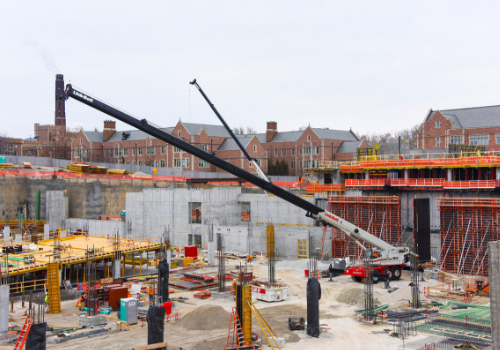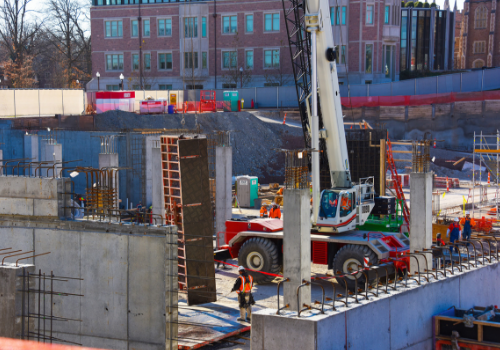Developing a rigging plan is crucial for safe and productive lifting. It is more important to develop and execute a detailed and accurate lift plan than just about any other construction application. If you don’t develop a detailed and accurate earthworks plan, you may be over schedule and over budget, but if you don’t develop a detailed and accurate lift plan, the consequences can be catastrophic.
“Nothing would seem to be as critical as a crane on a jobsite, cranes seem to have the highest visibility and a missed step in lift preparation can make for trouble,” says Pat Collins, Director of Product Marketing, Link-Belt Cranes.
In construction, crane operators develop a rigging plan with every lift. The lift plan should identify hazards, safety precautions, maximum capacities, machine position, environmental conditions and other risks.
Rigging plans are categorized as ordinary, critical and pre-engineered lifts. Ordinary lifts are routine lifts that require only rigging basics and minimal safety precautions. A critical lift is a non-routine crane lift that requires detailed planning and additional or unusual safety precautions. Lifts made where the load weight is greater than 75 percent of the rated capacity of the crane, lifts where the load moves out of the operator’s view and tandem lifts are all examples of critical lifts. A pre-engineered lift is one that is common to production. The lift objects are the same, they get lifted repeatedly and in the same environment, and a lift plan isn’t needed each time a lift is performed.
The best cranes can fail if the rigging plan doesn’t properly account for all factors that will be part of a lift. In order to ensure proper rigging techniques and a safe lift, take the following steps when creating your rigging plan:
1. Consider the Load
“One of the most important factors in lifting is what you are lifting, because the size, the shape and the weight of the material can vary greatly from one project to the next,” says Debbie Dickinson, CEO, Crane Industry Services, LLC. “What you are lifting is going to have a direct correlation to a crane’s capacity. You have to use a crane and rigging that allow you to be able to safely lift an object and that you stay within the capacity of your rigging and your crane.”
You not only need to consider the weight and dimensions of the load, but also the location of the load’s center of gravity and the location and quantity of approved lifting points in order to safely position your load.
Link-Belt Cranes has a tool called Link-Belt Pulse to aid operators in identifying load weight relative to maximum capacity. “It is the information center of crane performance to the operator,” says Collins. “Its most important job is to indicate in real time the weight of the lift on hook compared to the maximum capacity weight for the present configuration of the machine. It also gives a thorough analysis of all the critical geometry to your lift; it watches where you are going with the load because the machine’s capacity will most likely change as the load moves along the lift path.”
 2. Consider the Lift Environment
2. Consider the Lift Environment
A rigging plan has to account for not just the load, but also the environmental conditions. “By environmental conditions, I mean anything from working alongside a river to the presence of wind tunnels to congested areas to tight corners to working in close proximity to the public, as well as local weather conditions,” says Dickinson.
This also means considering what will be directly under the crane when it is lifting. “Are there any structures underneath? Are there any pipes? Is there solid footing underneath? Is there sensitive ground bearing issues? If working in a street, are there any curbs or washouts?” asks Collins.
3. Consider the Personnel
Are you lifting the load over people? Is there a danger to anyone if the load drops? Are you lifting people? A lot of questions need to be answered in order to follow safe lifting and rigging procedures.
Also, identify the load manager/rigging leader and the crane operator. For critical lifts, assign a person in charge (PIC). Make sure all personnel involved are aware of their duties during the lift.
Evaluate your operator. “Operators should be evaluated for their qualifications for safely operating a type of crane. Certification is not enough. It’s a driver’s license; it’s a starting point. It doesn’t qualify you for every crane situation. The ability to qualify operators based on their type of work and the types of machines that they have run is essential for safe operation,” says Dickinson.
4. Consider the Machine
Choose a crane that is appropriate to the application and need. “Often, the market requires the right machine for the right job. You can’t always just over spec the machine; project economics and jobsite environment play an important role in crane selection as well,” says Collins.
“Always refer to the operator’s manual; don’t defer to what you have known from previous jobs,” says Dickinson. “Just because you have operated that same model crane before, that doesn’t mean all the specs will be the same on this machine. Cranes can be configured differently. Small machine differences can have operational differences.”
 5. Conduct a Pre-Use Inspection
5. Conduct a Pre-Use Inspection
Verify that all components are in good condition. Verify that all equipment has been properly inspected and that such inspections are valid.
Critical checks for hoisting and rigging safety include:
- Checking the rope for kinks, cuts, breaks, corrosion and broken strands of wires, as well as making sure it is well lubricated
- Inspecting the hook for cracks, twisting, straightening and hook throat opening
- Ensuring that the sling choice is appropriate and without holes, cuts or crushed webbing
- Checking that the bridge bumpers and the trolley end stop are not loose, missing, or placed improperly
- Checking for wear in the machine’s wheels, brakes and bearings
- Ensuring control buttons are identified properly and function
By taking these five steps, contractors will raise their chances of executing their lift plans without incident.
Join over 32,000 industry peers who receive construction industry news and trends each week. Subscribe to CONEXPO-CON/AGG 365.












